History of Bharatpur/Chapter II
By Jwala Sahai
Printed by Lall Singh, in Moon Press, Agra, 1912
Chapter II
Early Period
Page 16

Thakur Braj, the founder of the Bharatpur State held Sinsini and taking advantage of the sanguinary wars among the successors of Auraugzeb set up as a freebooter. Beginning his predatory career with 200 followers, he soon gained proportions which enabled him to plunder the baggage of the Mogal army on its way to Dakhan and take possession of Au by expelling the imperial garrison. Sinsini was attacked and captured and Braj and his fourth son Bhao Singh were killed in the defence.
The conquest of Sinsini, which though with only thirty Villages scarcely deserved to be called a State, was considered as that of a kingdom, for, Rana Amar Singh of Udaipur applied the emperor for an increase of 1000 in his mansab in the glory of the victory at Sinsini and probably his contemporary Rajput chiefs serving in the imperial army may have made similar request.
Thakur Badan Singh, the son of Bhao Singh, succeeded in Sinsini and Thakur Churaman the seventh son of Braj formed the separate State of Thun and possessed it with eighty villages.
Thakur Churaman
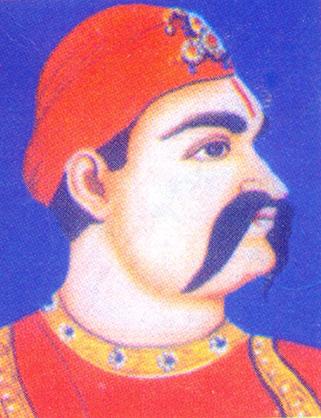
Being acknowledged as the head of the Jats, Churaman carried on his plundering excursions to the royal abode at Delhi and cut off communication of the capital with Ajmer, Gwalior and Agra.
In order to reclaim Churaman, Emperor Farukh Seir in 1714 sent his Vazir Sayad Husen Ali Khan and conferred upon him the title of Bahadur Khan and Jagir of Nagar,
Page 17
Kathumar, Au and Helak. But Churaman's ambition was not satisfied with these gifts and after a short interval he recommenced his former avocation.
The emperor, in 1716, directed Raja Jai Singh of Jaipur to expel Churaman. Thun and Sinsini were simultaneously invested, but the Jats even in the very infancy of their power evinced the same obstinate skill in defending their mud forts as in later times gained them so much celebrity: Jai Singh was foiled and compelled to retire. Churaman wisely propitiated the Sayad Vazirs who procured for him the emperor's pardon.
On his accession in 1720 under the tutelage of the Sayads, emperor Mohmad Shah with Sayad Husen Ali Khan marched from Agra on an expedition to Dakan and Sayad Abdulla went to Delhi to carry on the administration. A conspiracy was simultaneously at work to emancipate the emperor from the thralldom of the Sayads, Husen Ali was murdered on the way at Toda Bhim whence the emperor changed his course to Delhi and Abdulla putting a prince named Ibrahim On the throne marched from Delhi to oppose him.
Thakur Churaman, though under great obligation to the Sayads and therefore a staunch advocate of their cause, owing to the vicinity of his state, was persuaded by Amin Khan the new vazir to "appear in the imperial camp and serve the emperor, but he acted with fidelity to the Sayads, First he took the imperial army by a circuitous route in which they suffered much from fatigue and want of water; and when the combatant armies approached each other, he fell upon the imperial camp from right and left and took a way what he could lay his
Page 18 hands upon. On the 13th November 1720, when Abdula was defeated he plundered both sides with strict impartiality, and made off with the booty to his native country. He also received 2,00,000 gold mohars as present from the Sayad.
On suspicion of the murder of Nilkanth Kagar, Deputy Governor, being committed at Agra at Churaman's instigation, Jai Singh was appointed Governor of Agra and sent with a large army to revenge the outrage. Meanwhile Churaman poisoned himself in a quarrel with his son Mohkam Singh, who while disdaining to preserve any semblance of subordination to the Court of Delhi, imprisoned Thakur Badan Singh, his cousin in the senior branch of the family. The Jats were very irate on this and putting pressure upon Mohkam Singh caused Badan Singh's release.
Raja Badan Singh
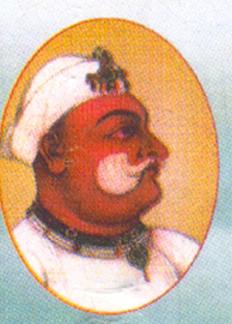
No sooner did Badan Singh obtain his freedom than he hastened to join Jai Singh in the imperial camp. Mohkam Singh gallantly defended himself for six months, but this time there was a Jat against the Jat, he could resist no longer. The assailants triumphed and Mohkam Singh fled for life.
Jai Singh was highly thankful to Badan Singh not only for his success with his help, but also for saving his life by preventing from entering the fort immediately on its capture, which he was impatient to do, as the fort had been undermined by Mohkam Singh. A terrible explosion which soon after overturned the fort (since then called "Ondha Thun") proved Badan Singh's wisdom and foresight which saved Jai Sing's life.
Raja Badan Singh - Badan Singh took possession of Thun as well as of Dig (originally Dirgh, meaning great in Sanscrit),
Page 19
where he was installed as Raja and spent much of his time at Jaipur, where Badanpura one of its environs is named after him. He erected numerous buildings at Dig, Kumher and Wair. Badan Singh took a prominent part in the battle between Jai Singh and Abhai Singh the Maharajas of Jaipur and Jodhpur respectively in 1740, and the fall of the tutelary deity of Bukht Singh (brother of Abhai Singh) into the hands of the Jaipur prince, the sale trophy of the war which he could be proud of, was due to Badan Singh's exertions.
Maharaja Suraj Mal
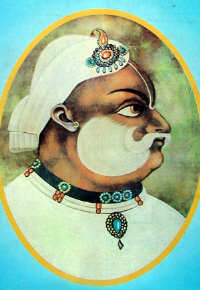
Maharaja Suraj Mal - Suraj Mal was the wisest, bravest and greatest of all the rulers of Bharatpur and a most influential personage of his time. He kept up his allegiance to Jaipur as far all it was practicable.
On the celebration, by Maharaja Jai Singh, of the rites of an Aswamedh Yagya, he was allowed to perform the duties pertaining to his sons, who being at variance with each other relinquished them, and Suraj Mal in return for the duties received his paternal blessings. In virtue of this extraordinary favour he built, the Dig fort and the palaces in it.
In the dispute for succession between Ishri Singh and Madho Singh, the sons of Jai Singh, while the cause of Madho Singh was supported by the Maharana of Urdaipur and Malhar Rao Holkar, Suraj Mal took the rightful part of Ishri Singh the elder and bravely defeated Madho Singh in the actions at Raj Mahal, Bagru-Mahlan and Moti Dungri and received presents of thanks giving from Ishri Singh.
On the death of Ishri Singh and succession of Madho Singh in 1751, the latter bore a malice against Suraj Mal not less strong than he had for his late rival brother. From this time
Page 20
the friendship between Jaipur and Bharatpur turned into an enmity.
Making a league with Malhar Rao Holkar and Gazi-ud-din the Delhi Vazir, Madho Sing invaded the Bharatpur territory in 1754, but Suraj Mal with his increased resources and strength of his forts was enabled to baffle the combined forces. They were forced to retire when Khande Rao the Son of Hulkar was killed in the siege of Kumher, a few miles. to the north of which Khande Rao's cenotaph exists at Gangarsoli.
In 1733, Suraj Mal attacked and destroyed the fortress of, Bharatpur, killed its Possessor Khema Jat and built the new and larger fort in its place. The mud fort with its masonry ramparts, the moat around, the two gates and bridges, eight bastions and numerous houses and temples, was completed in 1756.
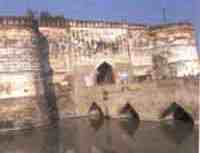
In 1745 Nawab Fateh Ali Khan of Kol, (Aligarh) who held ten districts, was attacked by Asad Khan a general of Ahmad Shah the emperor. When reduced to extremities, the Nawab solicited the help of Suraj Mal who promptly reaching the spot not only rescued Fateh Ali Khan from danger but also slew Asad Khan in the battle. In 1748 Saadat Khan the Amir-ul Umra advanced upon Bharatpur to avenge Asad Khan's death, but Suraj Mal defeated him at Naugaon near Kama.
Mansur Ali Khan Safdar Jang, the Nawab of Oudh, was appointed Vazir to Ahmad Shah the emperor and thenceforth called Nawab-Vazir. In 1749 he Was much harassed by tha Ruhelas and Ahmad Khan Bangash the Nawab of Farukhabad who rising in revolt, killed the Nawab's deputy Raja Nawal Rai. As desired by the emperor the Nawab-Vazir called in
Page 21
the aid of Suraj Mal and Hulkar who joined him with their armies and in the action which took place at Shamshabad Mau, the Pathans were defeated, one of them Rustam Khan, was killed by Suraj Mal and Ahmad Khan was forced to fly to the lower regions of Himalia. The conquered country was divided among the confederate powers.
Rao Bahadur Singh, a powerful Badgujar Rajput Chief of Ghasera, (now in Gurgaon district) bore jealousy towards Suraj Mal and also failed in his duty towards the emperor. With the sanction of the emperor received through Mansur Ali Khan, Suraj Mal invaded his country, captured the fort and killed the Rao.
Incurring the displeasure of the emperor for the murder on 28th August 1752, of Jawid a favourite eunuch of the emperor and his mother Qudsia Begam, who had supplanted the Nawab- Vazir's influence, during the time he had been in Ruhelkhand, Mansur Ali Khan was expelled from the capital. At his request Suraj Mal and his son Jawahar Singh with 15,000 men marched from Ghasera and joined the Nawab Vazir at Faridabad. They moved upon Delhi and Gazi-ud-din the Captain General came out to resist them. There ensued a series of battles, in the first of which Suraj Mal captured the royal artillery at Arab Sarai ; in the second he carried his arms to the gates of the fort, massacred thousands of people and returned with immense booty; in the third between Talpata and Chaura-ki-garhi his general Rajendr Gir Gusain was slain and he was obliged to fall back on Tuglakabad. In three more actions which took place at Badarpur, Faridabad and Ballabhgarh, the imperial troops, reinforced with veterans sent by Mir Mannu, the Governor
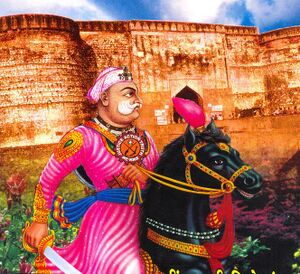
Page 22
Governor of the Panjab, were successful, as, the lengthening distances of the battlefields from Delhi evidently show.
Intzam-ud-doula, the new vazir, jealous of the growing power of Gazi-ud-din and at the mediation of Suraj Mal, persuaded the emperor to pardon the nawab-vazir and let him go honorably to his vice royalty which he did in 1753. Gazi-ud-din being thus slighted, could do nothing of the emperor and the vazirs, but he resolved to wreak his vengeance upon Suraj Mal. The emperor unwilling to carry on the war avoided to send the artillery required by Gazi-uddin; but in order to deceive him, marched in person with the avowed purpose of supporting him. He at the same time addressed a letter to Suraj Mal promising to fall upon the real of the army (his own) on the Jats making a Sally from their fort. This letter fell into Gazi-ud-din's hands and he returned it to the emperor with violent menaces. The alarmed monarch fell back upon the capital pursued by his rebellious general who on one hand deposed the emperor with great disgrace, and on the other invaded Suraj Mal by making a league with Hulkar and Madho Singh, the Raja of Jaipur. The result of this campaign has been already recorded.
In 1757 Suraj Mal suppressed the rebellion of Bhuri Singh and other Jat chiefs on the other side of the Jamna and captured Mursan and several other of their forts.
In the same year Shuja-ud-doula and Najib Khan at the secret consent of the new emperor Alamgir II, who though raised to the throne by Gazi-ud-din was soon tired of his oppressive conduct, invited Ahmad Shah Abdali (or Durrani) the king of Kabul. Among other measures to collect money, the Abdali sent his principal lieutenant Jahan Khan to levy
Page 23
contribution from Suraj Mal, but he was quite unsuccessful as strengthening the numerous forts with which his country was dotted, Suraj Mal cut off the foraging parties in sudden sallies and drove them out of his country. The invaders, then indemnified themselves in blood and plunder at the expense of innocent inhabitants of Mathura whom they surprised at a religious festival and massacred without the distinction of age or sex.
Gazi-ud-din once again acquired his power and putting Alamgir II to death made Shah Jahan II the emperor. Shuja and Najib again invited the Abdali king who suddenly made his appearance at the capital. Gazi-ud-din fled to Agra but many of his followers being cut down in pursuit by the Ahdali, had no other recourse than to fall upon the mercy of Suraj Mal who magnanimously afforded him shelter though he had always acted inimically.
At the request of Malhar Rao Hulkar, Baji Rao Peshwa sent an army of 100,000 men, under his son Biswas Rao and Sadasheo Rao Bhau as general; and Gazi-ud-din, Hulkar and Suraj Mal met them on the Betwa river. They advanced and at once took possession of Delhi. Shuja-ud-doula with the sanction of the Abdali met Biwas Rao, peace was concluded at the mediation of Suraj Mal, Ali Gohar (Shah Alam) was acknowledged as emperor and Shuja confirmed as his vazir. Each of the powers that met here was guided by its own interests, but the only thing in which they all agreed was a universal enmity to Gazi-ud-din who was forced to retire and live at Kama-Pahari as protege of Suraj Mal.
A subsequent discovery that the concurrence of the Marhatta leaders in his appointment as vazir had been purchased
Page 24
by Shuja-ud-daula at a cost of Rs. 500,000, alarmed and incensed the Abdali who declared a war against the Marahtas and annihilated their power for the time at Panipat on tho 14th January 1761.
At the time of joining the Marahtas with 30,000 hardy Jats, Suraj Mal had advised the Bhau to leave his infantry, guns and heavy baggage securely in his forts, to advance with his horse alone and harass the enemy in Marahta manner and to protract the war until the Durranis should he constrained by climate to withdraw to their native mountains; but the haughty leader of the Marahtas attaching undue importance to his regular infantry and artillery rejected this prudent counsel. Suraj Mal with his keen foresight secluded from the confederacy, left Delhi and by doing so escaped the carnage of the defeat. He on the contrary took advantage of it by putting the Marahta nation under great obligation with a very hospitable treatment of the fugitives on one hand, and by enriching himself with the acquisition of wealth and territories on the other.
Bhau himself being killed, his widow and half brother Shamsher Bahadur came to him, the former after the mourning period was honourably sent to her home, and the latter who died of wounds was duly buried and a tomb and Masjid built in his memory in the Mathura gate of Bharatpur. All other refugees were supplied with food, clothing and cash according to the want of each individual. Sir John Malcolm says :-
- " There is hardly a family of note in the Marahta nation that has not a tradition of debt of gratitude to the Jats of Bharatpur."
Page 25
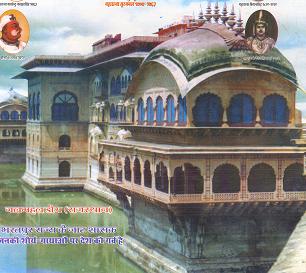
Pandit Naru Shankar the Marahta Governor of Delhi on his flight towards Agra was stripped of all his effects and treasures which were very considerable by Suraj Mal's order and he also took possession of the Agra fort with all the wealth of the empire stored from Akbar's time.
While thus at the height of his glory, Suraj Mal erected the fountain palaces called Bhawans, which as Thornton says,
- " are surpassed in India for elegance of design and perfection of workmanship only by Taj Mahal at Agra", and which have made Dig a place of great renown.
Encouraged by the weakness of the empire and emboldened by the employment of Sumru who entered his service with European and native troops and a park of artillery, Suraj Mal demanded the Fojdarship or military command of the capital and the districts around and actually took possession of Farukhnagar, Rewari and Bahadurgarh. Njib Khan the vazir failing to persuade Suraj Mal peaceably ordered to invade his territory, but before the imperial army could come out of the capital Suraj Mal arrived at Shahdara six miles to the east of Delhi. Whilst recklessly reconnoitering with his personal staff only for the double purpose of arranging the troops and hunting in the royal park, he was suddenly recognised by a flying squadron of the Mogal horse under Sedu Khan Biloch who surprised and killed the party including Suraj Mal. The army marching in security from Sikandarabad under his son Nahar Singh was suddenly charged and routed by the advance guard of the Mogals (1763)
Maharaja Jawahar Singh
Maharaja Jawahar Singh- Jawahar Singh was the bravest, but most turbulent and head-strong of Suraj Mal's sons.
Page 26
He extended his father's dominions in his life-time by taking possession of Alwar and other districts on the west and northwest. His furious temper, however, did not allow him to put well even with his father and there was a regular fight between them at Dig; Jawahar Singh firing guns from Gopalgarh and Rambag and Suraj Mal replying them from the Dig fort and Shahburj, Jawahar Singh received a bullet in his foot that made him lame for ever and while he lay wounded on the bed, Suraj Mal , with his paternal affection could not help going to him to soothe his pain, and there the domestic quarrel ended.
Jawahar Singh's first act on accession was to revenge his father's death, and for this purpose he at the head of a large army of Sikhs and Marahtas and his own under Sumru marched upon Delhi and besieged it for six months. The city was plundered and a rich booty taken, of which the Hasht Dhati gate at the Northern entrance of the Bharatpur fort and the black marble throne before the Gopal Bhawan at Dig are prominent trophies. He would have taken possession of Delhi, but Hulkar suddenly deserted and Jawahar Singh was obliged to make peace with Najib Khan whom he met on the plain of Khizrpur and returned to his country.
Rao Partap Singh Naruka Rajput of Machehri (subsequently of Alwar), while at variance with his suzerain the Mahaaraja of Jaipur, fled to Jawahar Singh from whom he obtained Sharna (sanctuary) and village Dahra in Kumher for his maintenance and his agents Khushali Ram and Nand Ram shared his exile among the Jats. Though enjoying the protection and hospitality of Bharatpur, Partap Singh, on Jawahar Singh's proceeding on a pilgrimage to Pushkar in
Page 27
1768, left it at once and going to Jaipur represented that Jawahar Singh was bent upon invading Amber (Jaipur). Maharaja Madho Singh of Jaipur who already bore malice against Bharatpur easily believed the story and considering it an opportune act of loyalty, forgave Partap Singh's past errors and restored him to his favour and fief of Machehri.
That both on going and coming back, Jawahar Singh took a route leaving Jaipur and Amber about sixty miles to the south and that in his journey onward he committed no aggression, leave no room to doubt that he had no offensive intention and he was forced to fight in defence on return.
At Pushkar he met Maharaja Bijai Singh the wisest ruler of Jodhpur (as in Marwar every act done perfectly well is called Bijai Shahi) and by exchange of turbans with him established friendly and fraternal relations which hitherto continue between Bharatpur and Jodhpur.
This served as a cause of additional jealousy to Jaipur and a vast army was sent to obstruct his passage at Maoda-Mandoli some sixty miles to the north of Jaipur, A desperate conflict ensued and Jawahar Singh left the field for home, which was already his object, but the so called victory over the Jats proved destructive to Jaipur, of which almost every noteworthy chief was killed in the battle and Maharaja Madho Singh himself died of grief on the fifth day.
Col. Tod thinks, "this battle was the indirect cause of the formation of Machehri into an independent state," but since the rare ingenuity of the Naruka Rao had designed the battle purposely to weaken the two states and to form a third his own out of their parts, the battle was not an indirect but direct cause of the formation of the Alwar State.
Page 28
Shorty after his return from Pushkar Jawahar Singh went to Agra and was murdered there in the fort by one Shujaat Meo convicted of stealing a valuable Hukka (smoking pipe) of Delhi booty and as Mr. Keene in his "Fall of the Mogal Empire" says, "at the instigation of the Jaipur Raja." Jawahar Burj in the Bharatpur fort and Jawahar Ganj the better part of Dig are monuments of Jawahar Singh's reign.
Maharaja Ratan Singh
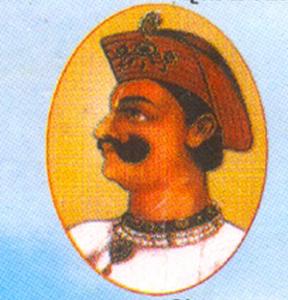
Maharaja Ratan Singh, a brother of Jawahar Singh, ruled only nine months during which nothing of importance occurred.
Maharaja Kehri Singh
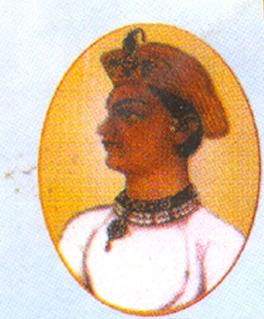
Maharaja Kehri Singh, the son of Ratan Singh succeeding at the age of two years in 1769, remained a minor throughout his reign to 1777, yet the period was very eventful from the dissension between Nawal Singh and Ranjit Singh his uncles for regency.
Mr. Keene says :
- " A period of very great confusion ensued in the Jat State; nor was it till two more of the sons of Suraj Mal had perished, one certainly by violence, (Ratan Singh had been murdered by Gosain who had cheated him), that supremacy of the remaining, Ranjit Singh was secured. In his time the Jat power was at its height; he swayed a country thick with strongholds from Alwar in the north-west to Agra on the south-east with a revenue of two millions sterling and an army of 60,000 men."
Nawal Singh besieged Ranjit Singh in the Kumher fort for four months. Ranjit Singh invited a vast Marahta army to help him, but Nawal Singh avoided collision with it by payment of Rs. 70,00,000 in lieu of which the districts to the east of the Jamna were ceded. On the 25th November 1775 Rao Partap Singh wrested Alwar and with it gradually north-western districts.
Page 29
Agra, as it will be seen, was taken possession of by an imperial general and thus in a short period the state was stripped of its numerous parts on all sides.
So much was, however, the Jat power dreaded at the Delhi court, that on the return of Shah Alam from Allahabad in 1771, a sum of Rs. 5,00,000 was provided in the imperial budget to carry on a war against them, and so much was it in reality that Zabte Khan, the son of Najib Khan, a bitter enemy of Suraj Mal, twice driven by Njaf Khan took refuge at Bharatpur and was on both occasions very hospitably sheltered.
Ranjit Singh by solicitations and Nawal Singh by aggressions urged Nawab Mirza Najaf Khan to make his intended attack upon Bharatpur, which owing to a difference among the ministers and their engagement in the affairs of Oudh and Allahabad had remained in abeyance.
On the complaint of Ranjit Singh, Najaf Khan sent an army under a Biloch leader against Nawal Singh who promptly made an obstinate resistance and not only forced the imperialists to retire but followed in hot pursuit and defeated them successively at Badarpur and Humayun's tomb. At the latter place the army had been reinforced by Najaf Khan but the defeat happened to be more painful as his nephew was slain in the battle (1772).
In 1773 Najaf Khan reduced the Agra fort and in 1774, while meditating a campaign against Bharatpur was urgently summoned to Ruhelkhand. Encouraged by his absence Nawal Singh advanced upon Delhi and occupied Sikandrabad with 10,000 horse. The force at Delhi was insufficient to resist
Page 30
but detecting conspiracy among his own followers Nawal Singh was obliged to make a retreat.
Reinforced by regulars and guns under Sumru, Nawal Singh again marched upon Delhi shortly after, but by this time Najaf Khan had returned from Ruhelkhand. Accompanied by Ranjit Singh, Hira Singh, Raja of Ballabhgarh and Najaf Kuli Khan, Najaf Khan advanced to oppose him after the reigns of 1774. Dislodged from Hodal Nawal Singh took up a position in the fortified village of Kotban where the Mirza endeavoured to blockade him. After amusing him with skirmishes for a fortnight Nawal Singh again fell back on Dig which was besieged by the Mirza. In the meantime a pitched battle was fought at Barsana where the Jats charged desperately and a momentary confusion was caused by the Mirza himself being wounded; but at last the imperialists overcame and the resistance of Sumru's disciplined troops served only to cover Nawal Singh's retreat with a show of order. Such was, however,the strength and resolution of the Jats that strictest blockade proved fruitless for 14 months to March 1776 at the end of which the fort Was reduced and the garrison escaped to the neighboring castle of Kumher. The Mirza took possession of the fort with vast quantity of ammunition and stores, a train of artillery, silver plates, stately equipage and ornaments and chests containing Rs. 6,00,000 cash. He built a Masjid adjoining Lachmanji's temple in Jawaharganj and his troops committed all sorts of violence on the helpless inhabitants including, the demolition of their temples and idols therein.
Nawal Singh died soon after his escape from Dig and his death was followed by that of Kehri Singh who was snatched
Page 31
away by small-pox; Ranjit Singh succeeded them successively in their respective capacity, first as regent and afterwards as ruler of the State in his own right.
Maharaja Ranjit Singh

Maharaja Ranjit Singh - Ranjit Singh met several reverses before he obtained a permanent footing, but his reign was destined finally to connect his and state's name with a deed of daring and in Indian annals of unsurpassed success.
Parganas yielding a revenue of nine lakhs of rupees had been restored to him by Nawab Mirza Najaf Khan at the intervention of his mother Maharani Kishori Ji; but Najaf Khan died in 1782, and Madho Rao Sendhia gaining ascendancy in the empire deprived Ranjit again of what had remained with him of his father's extensive dominions.
Mohamad Beg Hamdani, the Governor of Agra in special charge of Dig bore malice against Mirza Shafi the minister at Delhi; on the latter's coming on a tour of inspection to Dig, the Hamdani murdered Shafi at Au on the 23rd September 1783 and his tomb exists in the fort of Dig. Ranjit Singh seizing the opportunity of a quarrel among the imperialists turned them out and recovered his State.
Incensed at the loss of his friend Shafi in whose murder Ranjit Singh was supposed to have a hand, Sendhia again dispossessed Ranjit Singh of the State in 1784 and again all the representation of Maharani Kishori Ji, restored in 1785 eleven parganas yielding a revenue of ten lakhs per Annam including Dig.

Ranjit Singh took an important part in the invasion on Jaipur by the imperial army under Madho Rao Sendhia in 1786, and as Mr. Keen says, Sendhia made vast efforts to conciliate Ranjit Singh by costly presents and propitiated
Page 32
the feelings of the Bharatpur army. Ranjit Singh afforded material help to Sendhia in his escape to Alwar, Mathura and Gwalior after his defeat at Tonga, caused by the treachery of Mohamad Beg and his nephew Ismail Beg, the former of whom paid the penalty of his guilt on the spot. Ranjit Singh also protected his siege train and heavy baggage in the fort of Bharatpur.
Ismail Beg and Gulam Kadir while investing the Agra fort held by Lakwa Dada, Sendhia's general, were constantly annoyed by the invasions of the Jats from without and never allowed to carry on their operations continually. On the arrival of reinforcement from Dakhan under Rana Khan, De Boigne, Listouneaux, Jiwa Dada, Babu Janarjan and others, the chiefs were lodged in the Char Bag palace (now in Victoria Hospital) and the troops were encamped round the city Bharatpur. Ismail Beg and Gulam Kadir who raising the siege of Agra came to oppose were defeated in the battle of Chaksana and forced to retire and renew the siege. The army remained at Bharatpur until reinforced again, it drove Ismail Beg from Agra and relieved Lakwa Dada in August 1788.
Since that time to the conquest of Aligarh by General Lake and surrender of Mr. Perron on the 29th August 1803, Ranjit Singh adhered to Sendhia's cause and continued to help his, generals De Boigne and his successor M. Perron, the latter of whom in return for Ranjit Singh's valuable assistance, ceded three parganas, Kama, Khori and Pahari of an annual income of four laks, in addition to eleven given by Sendhia. These fourteen pargnas constitute the state and are now divided into ten Tahsils.
- Note - Images are not part of the Original book but provided from Jatland Gallery to make content interesting.
Back to History of Bharatpur
Go to Chapter III

